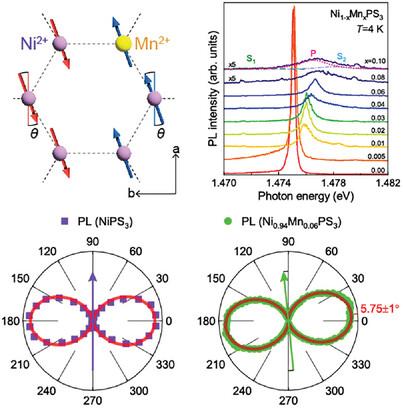当前位置:
X-MOL 学术
›
Adv. Funct. Mater.
›
论文详情
Our official English website, www.x-mol.net, welcomes your feedback! (Note: you will need to create a separate account there.)
Optical Probe of Magnetic Ordering Structure and Spin-Entangled Excitons in Mn-Substituted NiPS3
Advanced Functional Materials ( IF 18.5 ) Pub Date : 2024-07-01 , DOI: 10.1002/adfm.202405153 Je-Ho Lee, Seungyeol Lee, Youngsu Choi, Lukas Gries, Rüdiger Klingeler, Kalaivanan Raju, Rajesh Kumar Ulaganathan, Raman Sankar, Maeng-Je Seong, Kwang-Yong Choi
Advanced Functional Materials ( IF 18.5 ) Pub Date : 2024-07-01 , DOI: 10.1002/adfm.202405153 Je-Ho Lee, Seungyeol Lee, Youngsu Choi, Lukas Gries, Rüdiger Klingeler, Kalaivanan Raju, Rajesh Kumar Ulaganathan, Raman Sankar, Maeng-Je Seong, Kwang-Yong Choi

|
In van der Waals magnets, the interplay between magneto-excitonic coupling and optical phenomena opens avenues for directly probing magnetic ordering structures, manipulating excitonic properties through magnetic fields, and exploring quantum entanglement between electronic and magnetic states. Notably, NiPS3 stands out for its capacity to host spin-entangled excitons, where the excitonic states are intricately tied with the material's spin configuration. Herein, it is experimentally showcased that the spin-entangled excitons can be utilized for detecting the magnetic easy axis in Ni1-xMnxPS3 (x = 0–0.1). The end members of this series exhibit distinct magnetic ordering patterns and easy axes: zigzag ordering with magnetic moments aligned along the a-axis for NiPS3 versus Néel ordering with the out-of-plane easy axis for MnPS3. By combining angle-resolved exciton photoluminescence with magnetic susceptibility measurements, it is observed that the magnetic easy axis rotates away from the local spin chain direction with increasing Mn content. Moreover, through a comprehensive thermal and substitution study, it is demonstrated that the energy and lifetime of spin-entangled excitons are governed by two spin-flip processes and are drastically influenced by disparate electronic states. These findings not only provide optical means to map out magnetic ordering structures but also offer insights into decoherence processes in spin-exciton entangled states.
中文翻译:

Mn取代NiPS3中磁有序结构和自旋纠缠激子的光学探针
在范德华磁体中,磁激子耦合与光学现象之间的相互作用为直接探测磁有序结构、通过磁场操纵激子特性以及探索电子态和磁态之间的量子纠缠开辟了途径。值得注意的是,NiPS 3 因其容纳自旋纠缠激子的能力而脱颖而出,其中激子态与材料的自旋构型错综复杂地联系在一起。本文通过实验证明自旋纠缠激子可用于检测 Ni 1-x Mn x PS 3 (x = 0 –0.1)。该系列的端部成员表现出独特的磁排序模式和易磁化轴:NiPS 3 的磁矩沿 a 轴排列的锯齿形排序与 MnPS 3 的面外易磁化轴的 Néel 排序< b5> 。通过将角分辨激子光致发光与磁化率测量相结合,观察到随着锰含量的增加,易磁化轴远离局部自旋链方向旋转。此外,通过全面的热和替代研究,证明自旋纠缠激子的能量和寿命受两个自旋翻转过程控制,并受到不同电子态的极大影响。这些发现不仅提供了绘制磁有序结构的光学手段,而且还提供了对自旋激子纠缠态退相干过程的见解。
更新日期:2024-07-01
中文翻译:

Mn取代NiPS3中磁有序结构和自旋纠缠激子的光学探针
在范德华磁体中,磁激子耦合与光学现象之间的相互作用为直接探测磁有序结构、通过磁场操纵激子特性以及探索电子态和磁态之间的量子纠缠开辟了途径。值得注意的是,NiPS 3 因其容纳自旋纠缠激子的能力而脱颖而出,其中激子态与材料的自旋构型错综复杂地联系在一起。本文通过实验证明自旋纠缠激子可用于检测 Ni 1-x Mn x PS 3 (x = 0 –0.1)。该系列的端部成员表现出独特的磁排序模式和易磁化轴:NiPS 3 的磁矩沿 a 轴排列的锯齿形排序与 MnPS 3 的面外易磁化轴的 Néel 排序< b5> 。通过将角分辨激子光致发光与磁化率测量相结合,观察到随着锰含量的增加,易磁化轴远离局部自旋链方向旋转。此外,通过全面的热和替代研究,证明自旋纠缠激子的能量和寿命受两个自旋翻转过程控制,并受到不同电子态的极大影响。这些发现不仅提供了绘制磁有序结构的光学手段,而且还提供了对自旋激子纠缠态退相干过程的见解。






































 京公网安备 11010802027423号
京公网安备 11010802027423号